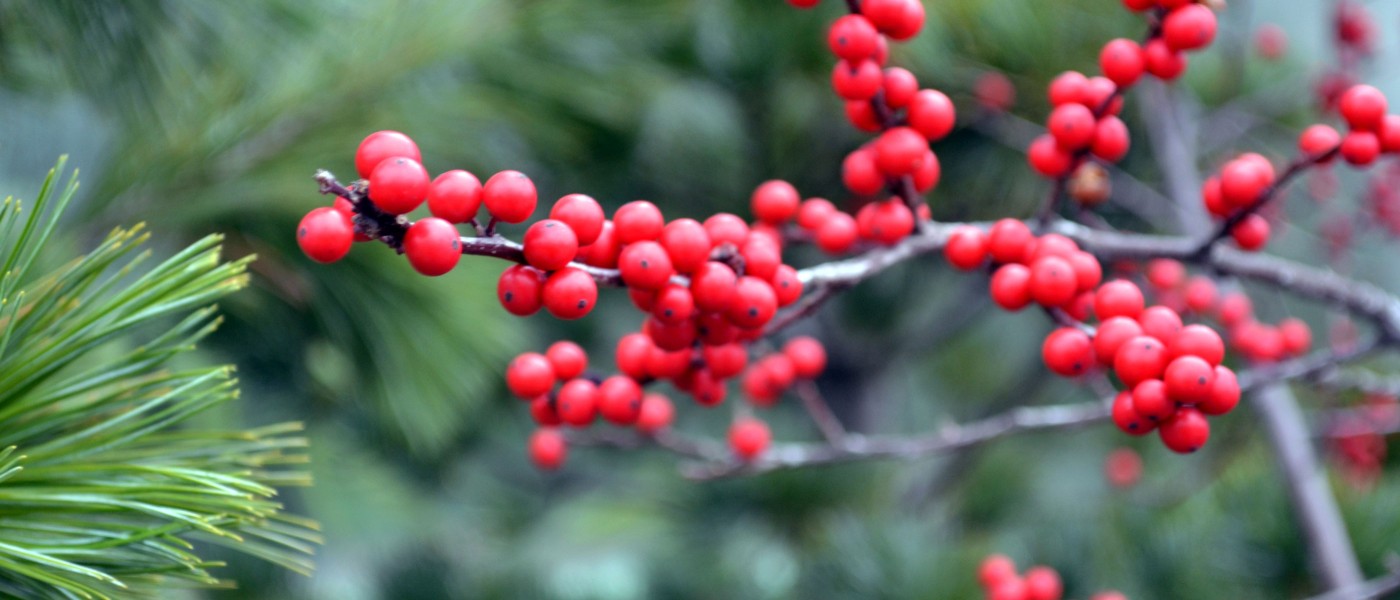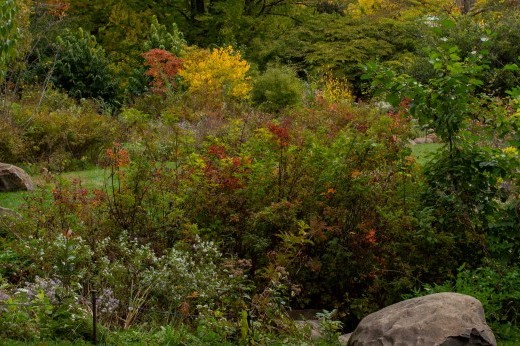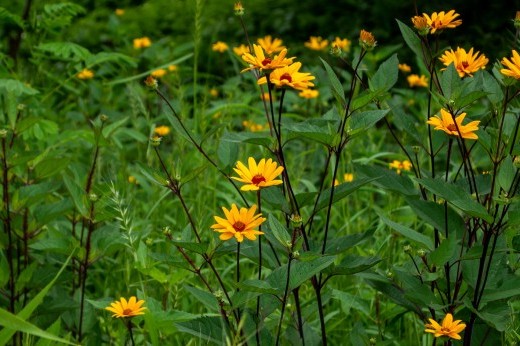Ask a Gardener is a seasonal advice column written by BBG gardener Laura Powell.
How can I attract birds and insects to my garden in the fall?
Masha, Ridgewood, NY
Dear Masha,
Fall is a great time to think about how to attract birds and insects to your garden. There are two main aspects to consider in your quest: plant selection and gardening practices.
When choosing plants, keep an eye out for species that are attractive to birds and insects. Plants native to your region are usually a good start, since they often provide food, shelter, or overwintering habitat for the insects and birds that evolved alongside them. The more diverse your planting, the more diverse your garden wildlife will be.
Looking for some examples? Eastern red cedar (Juniperus virginia), a drought-tolerant evergreen tree with powdery-blue berries, is so beloved by cedar waxwings that the birds are named after the tree. American winterberry (Ilex verticillata), a deciduous shrub with bright red berries, also attracts lots of birds in the fall and winter, from waxwings to bluebirds. The dried seed heads of black-eyed Susan (Rudbeckia hirta) and purple coneflower (Echinacea purpurea) are a goldfinch magnet; Rudbeckia and Echinacea species are also larval host plants for pollinators like the silvery checkerspot butterfly.
The way you tend your garden can make a difference, too. Planting in dense clusters instead of isolating individual plants helps attract wildlife. Birds and insects are more likely to flock to a mass of plants than a solitary bloom.
And while you may be tempted to cut back all your perennials as soon as they turn a little brown, leaving some areas wild can be beneficial. If you let the seed heads remain all winter, they’ll provide food for birds, while hollow stems left intact offer habitat for overwintering bees. Allowing fallen leaves to stay on the ground provides winter shelter for beneficial insects, too. The leaves will break down over time and nourish the soil.
Over time, even in the chillier, quieter part of the year, you will start to discover a dynamic ecosystem that supports itself in delightful ways.
Is it worth it to collect seeds from my plants? How do I collect seeds?
Kai, Brooklyn, NY
Dear Kai,
Collecting seeds is one of my favorite parts of gardening!
It’s a rewarding way to conserve resources; saving seeds from your plants this year means you’ll have fewer to buy next year. Plus, the seeds you collect from your garden will likely be better suited to your local growing conditions, making your plants more resilient to water shortages and pests as they adapt over generations. And exchanging seeds is a great way to connect with other gardeners.
Before you start, keep in mind that not all seedlings will be identical to the parent plant. Straight species are more likely to “come true from seed,” meaning the offspring plants will have the same characteristics as the parent plants. Most cultivars (cultivated varieties) and first-generation hybrids are less predictable, and some produce seeds that are sterile.
Your best bet if you want the offspring to resemble the parent plant is to collect from straight species or heirloom varieties.
Here are some steps you can follow:
- Choose healthy plants. Pick the best-looking, most vigorous and productive plants for seed saving. You want to pass on those strong genes to the next generation.
- Allow the seeds to mature. Some fruits (like beans or peas) should be dry before collecting the seed. Others will still be wet (tomatoes, peppers), but should be fully ripe when you collect.
- Harvest seeds. How you do this depends on the type of seed:
- Dry seeds: Wait until the seedpods or heads turn brown and dry. Then break open the pods or head and collect the seeds. (Watch my colleague Patrick demonstrate on a sunflower.)
- Wet seeds: Scoop the seeds out of the fruit, separate from the pulp, and rinse. Spread seeds out and allow to dry completely. (Learn how to save tomato seeds.)
- Store seeds. Place dry seeds in storage containers (paper envelopes work well), and keep in a cool, dry place. Don’t forget to label with the plant name and date.
- Plant or share soon! Seeds have a shelf life, so don’t wait more than a year or two before planting or sharing them.
Seed saving is a meaningful way to connect to the cycles of nature, so enjoy the process. Even though fall seems like an ending, collecting seeds reminds us that a new beginning is just around the corner.
Can I plant local flora and expect it to thrive with the rain, as opposed to me having to water it all the time?
Sophia, Brooklyn, NY
Planting local flora, also called native plants, is an excellent way to create a low-maintenance, ecologically friendly garden. Native plants are more likely to be adapted to the local climate, soil, and rainfall patterns, which means they typically require less water, fertilizer, and general care than nonnative species.
However, it’s important to note that while they are more resilient, you can’t always rely on rainfall to sustain them. Even native plants will need extra water sometimes, especially when they are newly planted and still establishing their roots.
Backing up for a moment—what’s a native plant, again? Here in the U.S., if a plant grew in a given region prior to European colonization (a lot of plants, including many that now function as weeds or invasive species, came with Europeans), it’s generally considered native. Another way of thinking about it is that a native plant has been around long enough to coevolve with local flora and fauna.
This definition does not guarantee that every native plant will thrive without supplemental water in our area today. Our concrete-packed city—and our climate—is different than it was 200 or 500 years ago, so not everything that grew easily and naturally in this area in the year 1500 will grow readily now.
Plus, the term “native” can be a bit broad. Some people use it to refer to plants from within a hundred-mile radius (this is the rule that guides planting decisions in BBG’s Native Flora Garden) or in a particular ecoregion, while others might use it to refer to plants from the Northeast, or even from within the continental United States.
I don’t mean to overcomplicate the issue, but as your trusty garden advisor, I feel honor-bound to clarify that choosing native plants is not a magic formula to make your garden low-maintenance and drought tolerant. You must also do what wise gardeners always do: Choose the right plant for the right place.
It is important to consider the specific conditions in your garden (sun exposure, soil type, microclimate) when selecting plants. If you plant a native, shade-loving plant in full sun, it will be neither low-maintenance nor drought tolerant—but situated in a shady area, it could potentially thrive with little attention from you.
Native plants are a great option, both for the environment and for shortening your to-do list—just select them carefully, site them appropriately, and give them lots of water early on to help them get started.
Got a question for Laura? Submit questions for our winter installment of Ask a Gardener using the form below.



